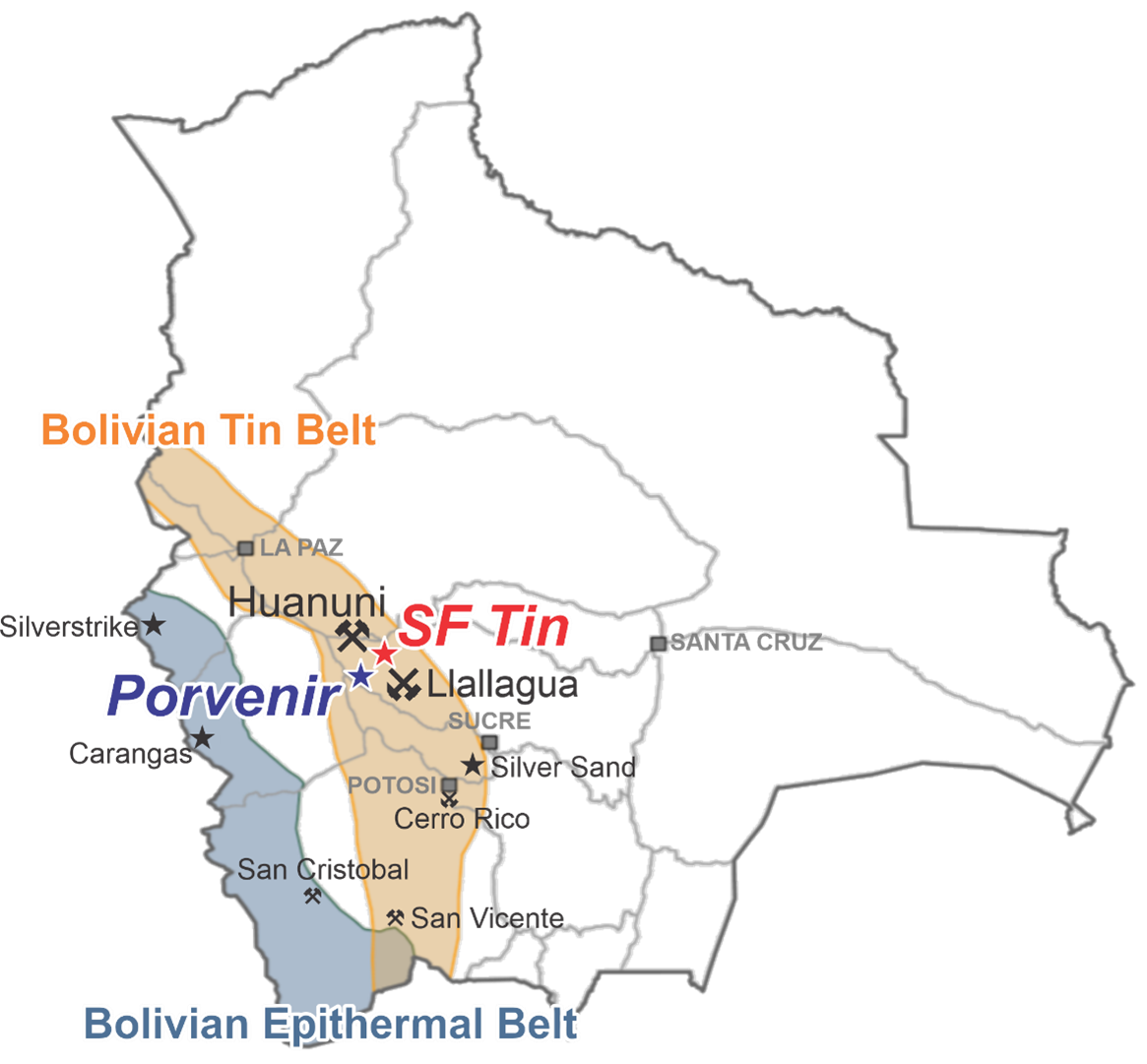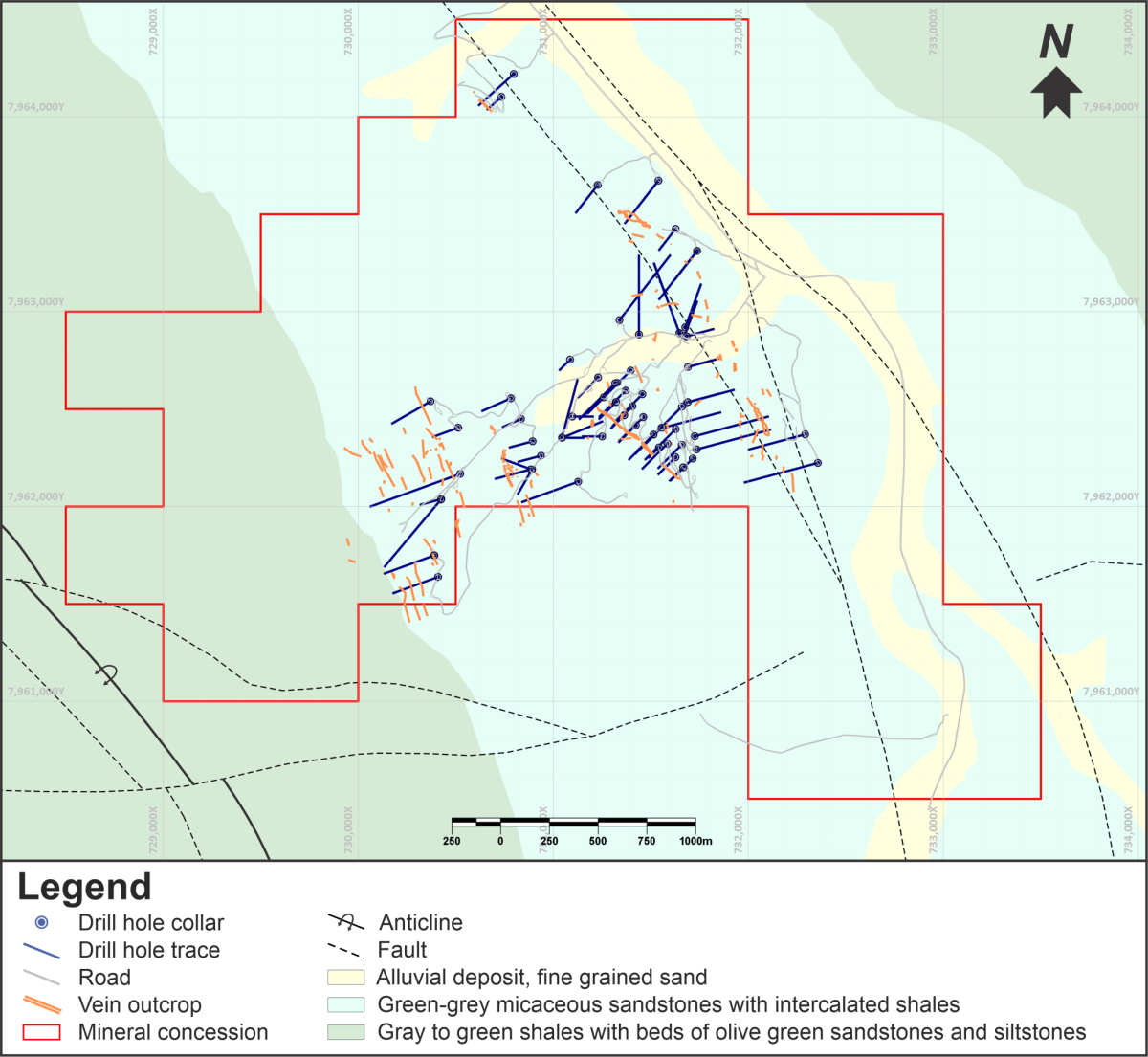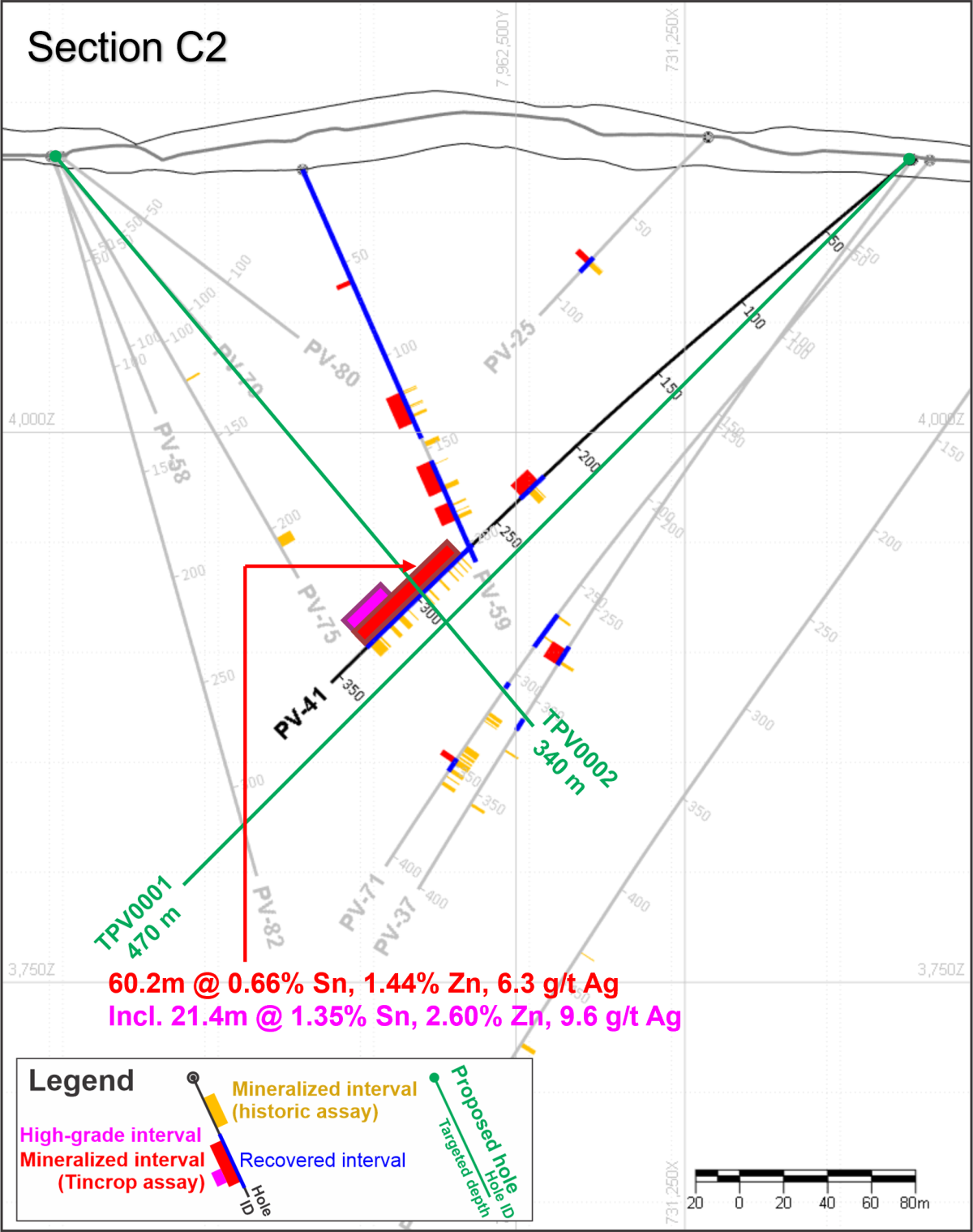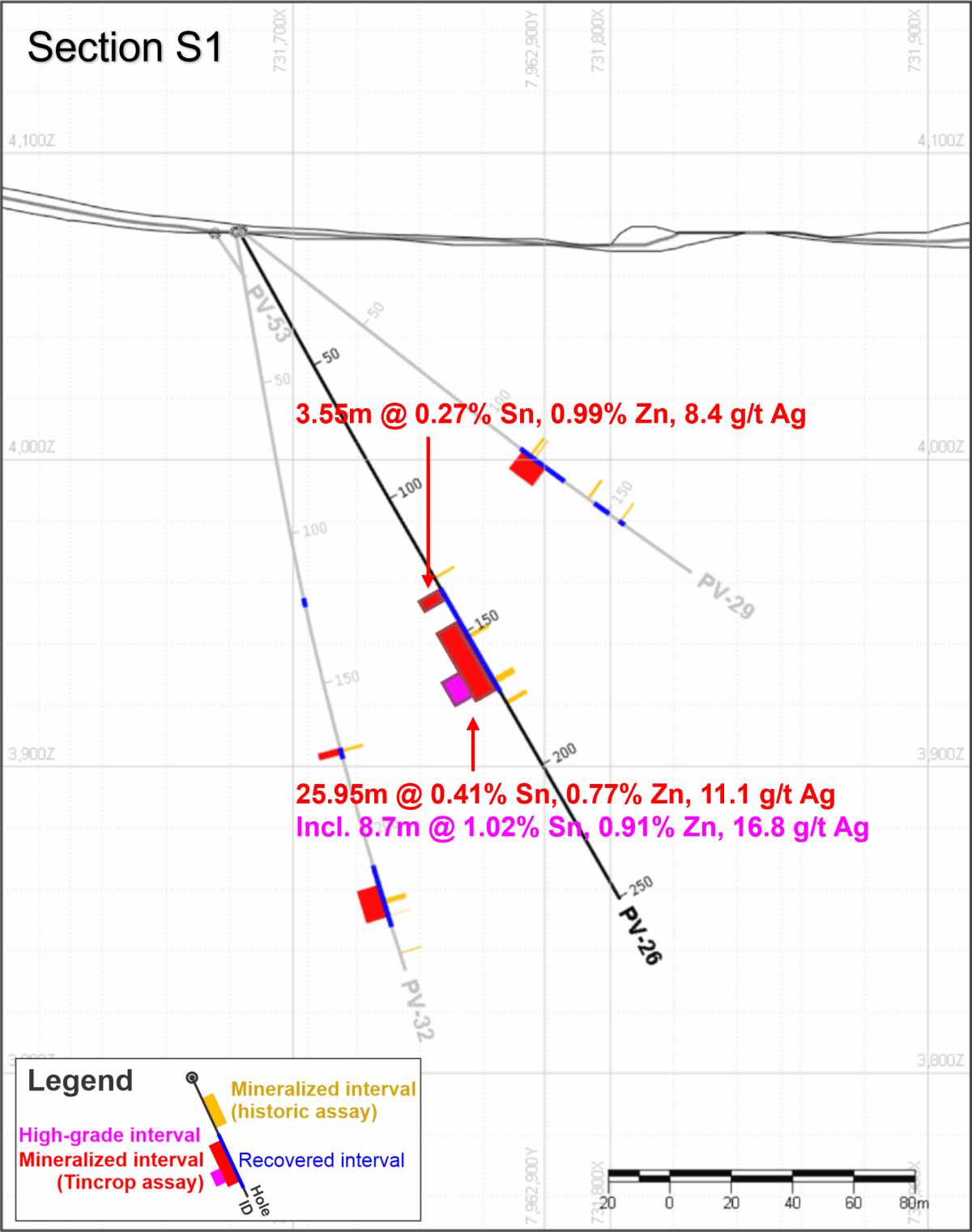Overview
The Porvenir polymetallic tin-zinc-silver (Sn-Zn-Ag) project is situated in the centre of the Bolivian Tin belt, 65 km southeast of the city of Oruro, in the Oruro department (Figure 1). The project is Only 15 km south of the Huanuni Mine, Bolivia’s largest tin mine. Tincorp owns 100% of the property and has a valid social agreement with the local community.
Figure 1: Location of the Porvenir polymetallic Sn-Zn-Ag project.
The 11.25 km2 property encompasses a historical near-surface open pit and underground workings; deposit was exploited on a limited scale. The mineralized structures were primarily exploited for their high-grade Zn contents.
Between 2007 and 2011, the Japanese mining company Dowa Metals & Mining Co. Ltd. (Dowa) conducted an exploration program on the project, which involved a drilling program of 88 diamond drill holes, totaling 26,959m. The drill hole traces are shown in Figure 2. Only 918 m cores of high-grade Zn were selectively sampled and assayed by Dowa. The drilling program identified more than 19 tin-zinc veins assaying up to 941 g/t Ag, 6.34% Pb, 28.1% Zn and 10.20% Sn.
Figure 2. Geologic map of the Porvenir polymetallic project.
Geology
Rock outcrops in the project consist of Silurian sedimentary rocks (Figure 2). The major rock types are greenish-gray micaceous sandstones and greenish-gray to dark-gray micaceous shales, which are partially silicified and kaolinized by hydrothermal solutions.
The tectonic and structural evolution of the area is manifested in folding, faulting, and low-grade metamorphism affecting the Paleozoic sedimentary rocks. The dominant structural feature is the flank of the Challapacheta syncline whose 144° axis is located to the west and outside the mining property. The entire mineralized zone of the mine is located on the eastern flank of the Challapacheta syncline, where minor folds with vergence to the east are observed.
The mineralization is mainly hosted by near vertical NNW to NW trending structures (Figure 2). The mineralization mainly comprises massive and vein-hosted sphalerite, pyrite and pyrrhotite. Cassiterite and tetrahedrite are the primary tin and silver ore minerals, but not macroscopically visible. Quartz, siderite, barite, chlorite and kaolinite account for the majority of gangue and alteration mineral assemblages.
Relogging and Sampling of Historical Core
1315.5m of historical core from 37 holes was recovered and assayed by Tincorp in 2022, including 1391 samples. The new assays revealed much more extensive high-grade tin mineralization zone (Figure 3). The assays of the noted mineralized intervals are shown in Table 1.
Using drill hole PV-41 as an example of Dowa’s incomplete sampling and where we filled in the gaps: from 265.00m to 332.20m, 67.20m of core was 100% recovered by Tincorp. In this same interval, Dowa only sampled 29 samples covering 22.75m discontinuously, averaging 1.60% Sn, 3.24% Zn and 14.4 g/t Ag (Dowa’s incomplete, discontinuous sampling shown in yellow in Figure 3). Tincorp relogged and sampled the whole length and yielded an interval of 60.20m grading 0.66% Sn, 1.44% Zn, and 6.3 g/t Ag, which includes a 21.40m high-grade interval grading 1.65% Sn, 2.60% Zn, 9.6 g/t Ag (Tincorp relogging and assaying shown in red and pink in Figure 3).
Another example is drill hole PV-26: 39.00 m of core was recovered in PV-26, from 133.70m to 172.70m. In this interval, Dowa only sampled 7 samples covering 6.55m discontinuously, averaging 0.70% Sn, 1.57% Zn and 27.9 g/t Ag. Tincorp relogged and sampled the whole length and yielded an interval of 25.95m grading 0.41% Sn, 0.77% Zn, and 11.1 g/t Ag, including a high-grade interval of 8.70m grading 1.02% Sn, 0.91% Zn and 16.8 g/t Ag, and another interval of 3.55m @ 0.27% Sn, 0.99% Zn and 8.4 g/t Ag.
Table 1. Noted mineralized intervals revealed by Tincorp’s new assays
| Hole ID | From (m) | To (m) | Interval (m) | Sn % | Zn % | Ag g/t | AgEq g/t |
| PV-24 | 257.80 | 286.40 | 28.60 | 0.29 | 1.09 | 9.2 | 134.8 |
| PV-26 | 145.75 | 171.70 | 25.95 | 0.41 | 0.77 | 11.1 | 161.7 |
| Incl. | 161.00 | 169.70 | 8.70 | 1.02 | 0.91 | 16.8 | 356.4 |
| PV-29 | 116.00 | 125.50 | 9.50 | 0.18 | 0.84 | 8.4 | 92.0 |
| PV-32 | 218.10 | 229.00 | 10.90 | 0.24 | 0.85 | 11.6 | 113.7 |
| PV-41 | 223.40 | 234.00 | 10.60 | 0.24 | 2.57 | 9.6 | 171.7 |
| PV-41 | 272.00 | 332.20 | 60.20 | 0.66 | 1.44 | 6.3 | 255.7 |
| Incl. | 310.00 | 331.40 | 21.40 | 1.35 | 2.60 | 9.6 | 507.7 |
| PV-44 | 229.80 | 288.05 | 58.25 | 0.22 | 1.22 | 9.6 | 118.6 |
| Incl. | 247.50 | 263.00 | 15.50 | 0.52 | 1.22 | 10.3 | 209.8 |
| PV-59 | 119.20 | 135.60 | 16.40 | 0.16 | 0.94 | 7.2 | 88.3 |
| PV-59 | 155.95 | 187.60 | 31.65 | 0.16 | 1.10 | 5.4 | 92.1 |
Notes:
- Drill intercepts are core lengths, and grades are length weighted. True width of mineralization is unknown at this time.
- Silver equivalent [AgEq] is used for illustrative purposes, to express the combined value of tin, zinc and silver as a grade of silver. AgEq is calculated using US$0.81 per gram of silver, US$2,828 per ton of zinc and US$24,442 per ton of tin. As of April 14, 2023.
Figure 3: Cross section C2 showing drill hole PV-41 and proposed holes (shown in green) for 2023 drill program.
Figure 4: Cross section S1 showing drill hole PV-26.




